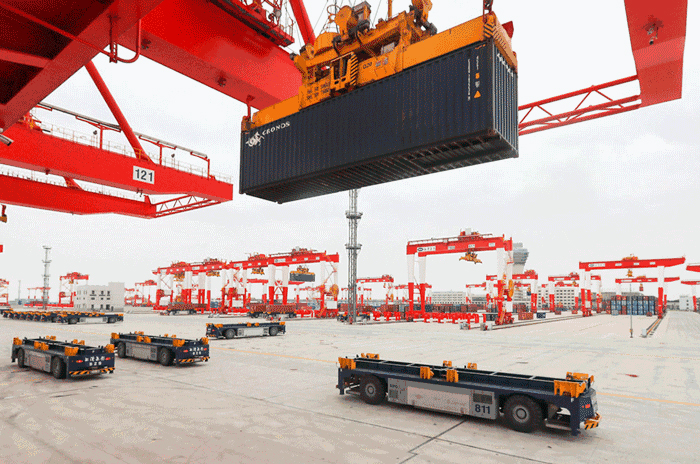The World’s Largest Automated Container Port
The fourth phase of Yangshan Port in Shanghai, China started trial operations at around 11:00 a.m. on December 10, 2017. This ‘Smart Giant’ seaport (constructed over the past three years and now offering seven large deep-water berths) has become the world’s largest automated container terminal.
The “magic container terminal” nickname for the systematic trial operations is largely attributed to an industrial wireless network built on Huawei’s first-of-its-kind 5.8 GHz Long-Term Evolution (LTE) technologies. To date, 4.5G LTE technology based on Third Generation Partnership Project (3GPP) standards is becoming a key accelerator for digital and automation transformation in diverse industries and sectors.
AGVs Efficiently Operate the World’s Largest Automated Port
“You will not find people working in the container terminal area. Everything becomes automated,” a worker explaining the “magic container terminal” nickname said. “For example, quayside container cranes are no longer driven by operators. Instead, they can be remotely operated from the background system, and container trucks have been replaced by freely moving Automated Guided Vehicles (AGVs) for loading, unloading, and transporting cargo.”
The expectation is that there will be 130 AGVs, 26 bridge cranes, and 120 rail-mounted gantry cranes to automate Yangshan Port. Devices previously operated manually will be replaced by smart ones. These smart facilities will automatically perform production tasks as instructed by the system. Workers will remotely control bridge cranes, rail-mounted gantry cranes, and AGVs. As a result, production operation environments will be improved, and the overall operational efficiency will be greatly increased.
AGVs function as a horizontal transportation system that is critical for automation services at the port. Subsequently, AGVs have received wide attention from the industry, and support unmanned driving, automatic navigation, path optimization, and proactive fault prevention. Additionally, AGVs are designed with self-fault diagnostics and self-powered monitor functions. Through wireless communication equipment and an automatic dispatching system, AGVs can move freely with precise positioning to accurately and systematically to complete instructions from the system’s brain.
What kind of network streamlines operational commands?

The Industry’s First-of-the-Kind 5.8 GHz LTE Builds a Reliable Network for AGVs
The AGV system poses the following stringent requirements on wireless communication networks:
At the very beginning, Yangshan Port implemented a traditional industrial wireless network to transmit AGV control signals. This conventional network performed poorly, especially for network coverage, mobility, and multi-AGV access capabilities. Therefore, it failed to stably transmit AGV control signals. As a result, the entire set of AGV automatic driving systems could not meet commercial use requirements.
The Yangshan Port management also found other traditional wireless solutions unfeasible. Starting from the beginning of 2017, port decision-makers were impressed by Huawei’s industry-leading 5.8 GHz LTE wireless technology, eLTE-U. Using the most-advanced 4.5G LTE technology, Huawei’s eLTE-U provides reliable LTE wireless connections on the 5.8 GHz unlicensed band, eLTE-U achieves a perfect combination of easy deployment with additional high-performance LTE functionalities.
After nearly a year of verification, eLTE-U is finally put into trial operations in the fourth phase of Yangshan Port. This provides the most-reliable wireless network for moving cargo to and from destinations around the world.
4.5G Wireless Enables Industry Digitalization
Now, Yangshan Port efficiently operates as the world’s largest automated container terminal with the highest level of automation around the globe. Completion of the fourth phase marks a milestone for upgrading operational paradigms and technology in China’s port sector. Yangshan Port will help consolidate Shanghai Port’s standing as the world’s largest cargo-handling port, and further support Shanghai’s efforts to expand as the world’s top best-in-class shipping center.
The 5.8 GHz LTE network technology at Yangshan Port represents another of Huawei’s achievements in partnering to contribute advanced 4.5G wireless technology into specific industries. As network capabilities are upgraded from supporting mobile Internet to empowering the industrial Internet of Things (IoT), 4.5G LTE technology based on 3GPP standards is gaining popularity among diverse industries and sectors.
Looking ahead toward 5G evolution, Huawei will continue to work with more industry-leading partners who specialize in port machinery, electric power automation, industrial manufacturing, warehousing, logistics, and additional sectors. Huawei’s state-of-the-art 4.5G LTE is a better choice for helping industry IoT networks accelerate digital transformation across industries and sectors.